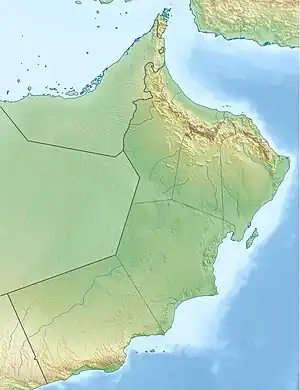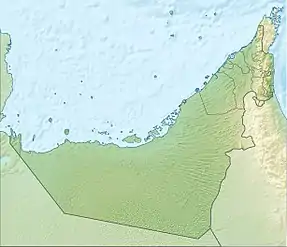Madha
مَدْحَاء | |
|---|---|
| Madha | |
 Flag | |
 Madha Location in Oman  Madha Madha (United Arab Emirates) | |
| Coordinates: 25°17′4″N 56°19′59″E / 25.28444°N 56.33306°E | |
| Country | |
| Government | |
| • Sultan | Haitham bin Tariq Al Said |
| • Governor | Sayyid Ibrahim bin Said al Busaidy[1] |
| • Wāli | ? |
| Elevation | 41 m (137 ft) |
| Population (2017) | |
| • Total | 2,473[2] |
| Time zone | UTC+4 (GST) |
The Omani territory of Madha (Arabic: مَدْحَاء, romanized: madḥāʾ) or Wādī Madḥāʾ (Arabic: وَادِي مَدْحَاء) is an exclave of the Musandam Governorate, enclaved by the United Arab Emirates (UAE); inside it, there is a second-order enclave: Nahwa, which is part of the UAE Emirate of Sharjah. Madha is located halfway between the Musandam Peninsula and the rest of Oman.
The exclave is on the Fujairah–Khor Fakkan road, which is mostly in the Emirate of Sharjah, and covers approximately 75 km2 (29 sq mi). There are two exits to Madha on the Fujairah–Khorfakkan road. This territory is the only territory between UAE and Oman which is not lined with any barrier and there is no border crossing between Madha, Nahwa, or the UAE.[3]
History
At the start of the 19th century, Madha belonged to the Qawasim of Ras Al Khaimah but the Shihuh of Dibba Bai'ah took it by force some time between 1869 and 1900. From that point, they had been aligned with the Shihuh from Dibba Bai'ah and their leader Muhammad bin Salih. The Madhanis determined that there was no point of staying with him and they needed a stronger government.[4]
In the late 1930s or early 1940s, the leaders of the four rival clans who ruled the Musandam Peninsula (Al Qassimi of Ras Al Khaimah, Al Qassimi of Sharjah, Al Sharqi of Fujairah, and the Bu Said of Oman) gathered a group of village elders of Madha and posed a question on to which sheikhdom the Madhanis want to pose allegiance to.[4] While all the other villages and towns around them (including the village of Nahwa that is within Madha) aligned themselves to the ruling families of Sharjah, Fujairah and Ras Al Khaimah, the Madhanis were swayed by the local representative, or wali, of the sultan of Oman Hamad bin Saif Al bu Sa'idi. The Madhanis chose Oman in the 1930s based on the firm belief that Oman was wealthier, had a stronger government, and would be better placed to protect the village's water supply. The boundary was settled in 1969 and Madha residents' decision to align with Oman made them an exclave of the Sultanate of Oman.[4][5]
Madha is mostly empty, with the developed portion, called "New Madha", containing roads, a school, post office, an 'Eid ground, police station, an Omani bank, electricity and water supply, and an airstrip. There is also a Royal Oman Police patrol.
The population is less than 3,000.[6]
In 2014, it was announced that a museum would be built to house the collection of local historian Mohammed bin Salem al Mad’hani.[7]
Climate
Madha is a mountainous area with rugged terrain, and the climate is hot and dry in the summers and mild in winters.[8]
| Climate data for Madha | |||||||||||||
|---|---|---|---|---|---|---|---|---|---|---|---|---|---|
| Month | Jan | Feb | Mar | Apr | May | Jun | Jul | Aug | Sep | Oct | Nov | Dec | Year |
| Mean daily maximum °C (°F) | 24.6 (76.3) |
24.6 (76.3) |
27.8 (82.0) |
32.8 (91.0) |
36.7 (98.1) |
37.9 (100.2) |
38.5 (101.3) |
37.7 (99.9) |
36.6 (97.9) |
33.9 (93.0) |
29.9 (85.8) |
26.1 (79.0) |
32.3 (90.1) |
| Mean daily minimum °C (°F) | 13.6 (56.5) |
14.1 (57.4) |
17.2 (63.0) |
20.7 (69.3) |
24.4 (75.9) |
26.6 (79.9) |
28.6 (83.5) |
28.3 (82.9) |
25.9 (78.6) |
22.1 (71.8) |
17.8 (64.0) |
15.2 (59.4) |
21.2 (70.2) |
| Average precipitation mm (inches) | 14 (0.6) |
36 (1.4) |
29 (1.1) |
9 (0.4) |
2 (0.1) |
0 (0) |
1 (0.0) |
0 (0) |
1 (0.0) |
1 (0.0) |
7 (0.3) |
15 (0.6) |
115 (4.5) |
| Source: Climate-data.org | |||||||||||||
Tourist Attractions
Water Springs
In the Wilayat of Madha there are some water springs, such as: Ain Al-Samay, which has a flow rate of three liters per second, and Ain Hajar Bani Hamid, which has a flow rate of about four liters per second.[9]
Sarooj Dam
The Sarooj Dam, which is situated in the Madha wilayat of the Musandam Governorate, is one of the city's main attractions. Following the recent rains, the dam has significantly filled up, creating a lake of fresh water, making it a well-liked destination for travelers who wish to take in the gorgeous views and the fresh water.[8]
Madha Fort
A number of historical structures can be found in Madha, including the Madha Fort, which is thought to have been constructed in the 17th century under the rule of Sultan bin Saif Al-Yarubi. The fort is a must-see for history aficionados and a superb illustration of traditional Omani architecture.[8]
Madha House Museum
Muhammad bin Salem Al Madhani founded it and started gathering his exhibits in 1976 AD. Numerous items and antiques from before the birth of Christ can be found at the museum, including pottery, coinage, and agricultural implements.
Inscriptions on stones, fragments of arrows, spears, and other ancient weaponry as well as seals, timepieces, and various Omani rocks are also included.
The museum displays a number of documents, manuscripts, and historical coins dating back to the tenth century AD, such as: a Greek silver coin used during the reign of Alexander the Great, a very small coin with a star made of stone on both sides, and a group of coins that were minted during the Umayyad and State eras. Abbasia.[10]
Cultural Festivals
Additionally, Madha is well-known for its annual cultural festivals. These celebrations feature traditional music and dance performances, culinary festivals, and arts and crafts exhibitions as they honor the region's rich history and culture.[8]
Crafts and Traditional Industries
Despite the growth and advancement that the Omani society has experienced in every facet of life, the preservation of the genuine Omani heritage has served as a cornerstone of the modern state and is one of the characteristics that set it apart from other societies, given that heritage plays a crucial role in defining the national identity. notwithstanding the enormous advancement in the instruments and production methods. Typical Omani crafts include:
Shipbuilding Industry
Due to the development of sophisticated marine businesses throughout the Sultanate at that time, the Sultanate has a long and rich maritime history.

Ships in Oman are built using two different techniques. The first technique involves aligning the boards side by side and using a fine hand drill to create holes at intervals to tighten the boards with ropes made of (coconut) fibers. Finally, these holes are covered with a mixture of fibers. Or raw cotton that has been saturated with fish oil, coconut oil, sesame oil, or both. The second technique used is the method of nails, which is a traditional technique used in the regions of the Persian Gulf and the Red Sea.
Jewelry and Silverware Industry
Silverware and ornaments are two of the most well-known and skilled traditional Omani industries. Omanis have been familiar with these industries since ancient times, and they are closely related to social occasions like weddings and holidays because they are essential components of women's adornment at weddings and other special occasions. The production of daggers and swords is a part of the national culture and civilization of the Omanis, and it carries with it geographical meanings, dimensions, and cultural and historical symbols for Oman as a region that has experienced some of the most trying historical periods and conditions.
Omani sweets Industry

Due to its reputation as an Omani symbol of generosity and creativity, Omani sweets are well-known both inside and outside the nation. The candy industry uses a variety of ingredients, such as flour, eggs, sugar, and water. It also uses ghee, almonds, saffron, cardamom, and rose water, which is typically imported from the Green Mountain. Not more than two hours. Gas and electric stoves can be used to make sweets, but it is preferred to use wood stoves, especially wood that has been harvested from (summer) trees because of its hardness and lack of smoke or odor.
Pottery

The potters were quite adept with their age-old method of employing a basic wheel turned by the foot, and the trade was quite sophisticated. They fueled it with chopped twigs and cooked the raw material in big brick kilns. In Oman, Bahla has long been the epicenter of pottery production, and in more recent years, this art has advanced thanks to the addition of unique Chinese materials. Other pottery-making regions with access to high-quality clay include Bilad Bani Bu Hassan, Samail, Musalamat, Muttrah, Saham, Salalah, and Bahla.
The Palm Industry

This industry came as a result of the Omani environment relying on the cultivation of palm trees, from which the Omani craftsman benefited from its natural raw materials in the creation of many local industries that the Omanis relied on in the past, such as the “Sima” rug, the “Zabeel” basket, and other daily use tools. The Public Authority for Craft Industries has once again renewed this industry in order for it to remain and to see Omani creativity in it, whether for those who love to restore heritage or residents who live inside the country or tourists who love to acquire Omani products. The mechanisms used in these industries keep pace with today's world in which many technological developments have entered.[11]
References
- ↑ "Prince William begins Oman visit in Musandam". Oman Observer. Retrieved 23 January 2020.
- ↑ "Data Portal". Sultanate of Oman National Centre for Statistics & Information. Retrieved 2021-08-03.
- ↑ Madha
- 1 2 3 "Madha village's pledge of allegiance changed the map forever". The National. Retrieved 2018-01-05.
- ↑ "A century-old choice created one of the Gulf's oddest geopolitical features". The Economist. ISSN 0013-0613. Retrieved 2023-01-14.
- ↑ Vaidya, Sunil K. (9 May 2009). "Tremors cause panic in Madha village in Oman". Gulf News. Retrieved 10 May 2013.
- ↑ HAQUE, FAIZUL (11 Aug 2014). "Madha Museum Drive in Oman Collects OMR300,000". Times of Oman. Archived from the original on 22 June 2015. Retrieved 22 June 2014.
- 1 2 3 4 "Exploring the Enclave of Madha in Oman". thepoliticswatcher.com. 2023-06-16. Retrieved 2023-08-12.
- ↑ "البوابة الإعلامية". البوابة الإعلامية -وزارة الإعلام - سلطنة عمان. Retrieved 2023-08-13.
- ↑ "البوابة الإعلامية". البوابة الإعلامية -وزارة الإعلام - سلطنة عمان. Retrieved 2023-08-13.
- ↑ "البوابة الإعلامية". البوابة الإعلامية -وزارة الإعلام - سلطنة عمان. Retrieved 2023-08-13.
External links
![]() Madha travel guide from Wikivoyage
Madha travel guide from Wikivoyage
